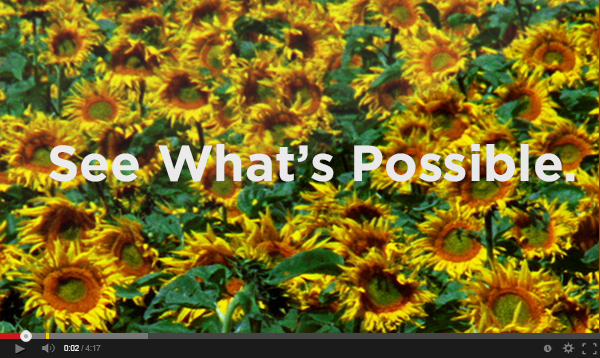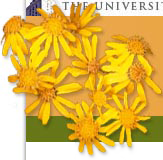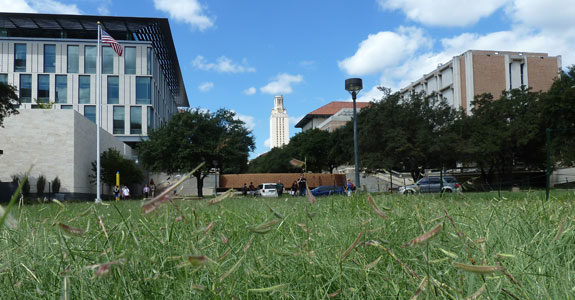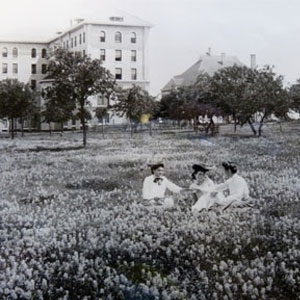Royal Blues - Fall 2014
Written by Bibi Wein
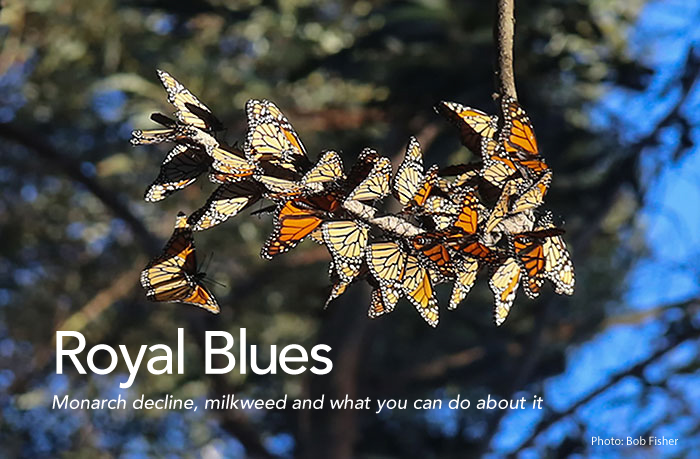
Above: Monarch butterflies only migrate during the day. At night, they gather in clusters called roosts.
Monarch butterflies are in trouble. Recently their numbers have dropped so precipitously that conservationists are sounding the alarm. Last winter, far fewer monarchs than ever showed up at their Mexican overwintering grounds, where scientists have been monitoring them since 1994 – only half as many as in 2012-13 and a mere 10 percent of the 20-year average.
“It’s a disturbing trend that’s been going on for most of the past decade,” says veteran monarch watcher Dr. Craig Wilson, senior researcher at Texas A&M University. “This year, monarchs have faced several threats including lingering drought, unusually cold winter temperatures and lack of milkweed, the only plant eaten by monarch caterpillars.” In addition, on the steep mountainsides of central Mexico, illegal logging continues to decimate old-growth oyamel firs, the only trees in which the overwintering butterflies roost. In 2013-14 they occupied only 1.65 acres of their winter habitat, compared to 2.47 acres the previous season.
“For what was once one of our most common butterflies, this decline is dramatic,” says Sarina Jepsen, director of the endangered species program at The Xerces Society for Invertebrate Conservation. “Twenty years ago, North America was home to more than a billion monarchs. Sixty million were estimated in 2012-13. Today’s estimate is fewer than 35 million.”
The monarch butterfly,
Danaus plexippus, has long fascinated humans, from scientists to toddlers. It is large, with distinctive orange and black markings that make it easy to identify, and the mystery of what Wilson calls its “magical migration” teases the imagination.
“It is a wonder of the world that a butterfly can fly 2,000 miles from as far north as Canada to an area where it has never been,” says Wilson. The monarch is the only butterfly known to make such a journey. And while there are small populations of monarchs in many parts of the world, only North American monarchs migrate. How do they do it? We know only that they fly south or southwest when temperatures cool in late summer or early fall and that they are probably guided in some way by the sun and the earth’s magnetic field. “Recent research suggests they have magnetic compasses in their antennae,” says Jepsen. “But the individuals that make this journey are at least four generations removed from the butterflies that flew north the previous spring. We know so little about how they find and roost in the exact trees where their great-great-grandparents roosted the previous winter.”
No single butterfly makes the round-trip. The butterflies that leave Mexico in early spring mate and lay their eggs on milkweed leaves in Texas, then continue north, mating and laying eggs until they die of old age, usually within weeks of leaving Mexico. The eggs develop into caterpillars that devour the milkweed leaves, then form a chrysalis or pupa from which a butterfly emerges. About a month after the eggs were laid, the new adult flies north to repeat the process. This happens several times until the fourth or fifth generation begins the long migration south. The adult butterflies of these middle-breeding generations live two to six weeks. The migrating generation will live eight to nine months, spending more than half their lives in Mexico, clinging in tight clusters to the bark and branches of oyamel firs, from which they get the warmth they need to survive in semi-dormancy. Monarchs can’t fly until the temperature reaches 55-60 F. When it does, they take off for Texas and begin the cycle all over again.

Above: Antelope horn (A. asperula)
By current estimates, some 33 million monarchs emerging east of the Rockies make this journey, while fewer than half a million that emerge in the west migrate to small wooded areas in coastal California. We’ll be talking primarily about the larger group, which appears more severely threatened.
A monarch’s life is hazardous at every stage of this complex cycle. Many things can go wrong at any point and, recently, many have. Among them, Wilson cites the effects of climate change. “Extreme heat can desiccate their eggs laid on the journey north in the spring, and wildfires have destroyed wildflowers that provide nectar for the adults. Monarchs are one of the canaries in the coal mine,” asserts Wilson. “They’re telling us climate change is happening.”
Jepsen points to other concerns. “More and more, we’re seeing declines in widespread and abundant species like the monarchs. I think this means we’re changing the landscape at an unprecedented scale.” These changes include loss of habitat to development and agriculture, resulting in a dramatic loss of milkweed, which has been catastrophic to the monarch.
What is best understood about monarchs is their link with milkweeds (
Asclepias spp.). The butterfly and the plant apparently evolved together. The female lays her fertilized eggs nowhere else. Milkweed leaves are the caterpillars’ only nourishment, and the toxins they contain protect monarchs from many predators throughout their life cycle. When a caterpillar pupates, the gem-like green and gold chrysalis attaches itself to the underside of a milkweed leaf until the butterfly emerges. There the exclusive relationship ends. Adult monarchs sip nectar from milkweed flowers and help pollinate the plant, but they feed from many other wildflowers as well.
Until recently, milkweeds were plentiful in the Corn Belt of the Midwest. That changed dramatically in 2006, when the push for ethanol production raised the demand for corn and soybeans. Corn and soy crops planted today are almost universally genetically modified to tolerate glyphosate herbicides that are sprayed on these fields by the millions of gallons. “The spray kills off all weeds and wildflowers, including milkweed that would have previously survived at field edges,” says Wilson. Between 1999 and 2009, 90 percent of common milkweed (
A. syriaca) vanished from the field margins of Iowa alone. Making matters still worse, intensive farming practices reduce the area between field edge and road, and excessive mowing of roadsides nationwide destroys more milkweed habitat.
A 2012 study estimated a 58 percent loss of milkweed from 1999 to 2010 in the Midwestern landscape, where half of monarchs are believed to begin their migration south, and a corresponding 81 percent decline in the butterflies. The disappearance of milkweeds in agricultural areas makes their presence in other habitats all the more important. One of these habitats could be your garden.
Texas gardeners are in a unique position to give monarchs a boost. “Milkweeds in Texas are critical for monarchs, as this is the second generation’s first stop after leaving Mexico,” Wilson points out. “But everyone throughout the country – especially in Iowa and the rest of the Midwest, all the way up through Wisconsin and Minnesota – can help by planting milkweed and other nectar flowers to provide a food source for the adults to give them energy to breed and to migrate, both north and south.”
Most milkweeds thrive in full sun, well-drained soil, and are drought-tolerant and unappealing to deer. They can provide height, color and structure in the garden and once established need little attention. Their sturdy stalks bear large umbels in a variety of colors, often so subtle they defy simple names like pink, white or green. The more milkweed species you can grow, with varying bloom times, the more monarchs your garden will support. The seedpods add interest when flowers and foliage die back. Brown when ripe, they’re 2 to 3 inches long and filled with silky white floss that helps the seeds fly off on the wind when pods burst.
“Milkweeds can be hard to get going,” cautions Wildflower Center director of horticulture Andrea DeLong-Amaya, but a little extra care at the start will produce long-lasting, problem-free perennials. Be sure to choose a locally native species, and avoid all pesticides and herbicides in the garden. When purchasing plants or seeds, look for an organic or “monarch-safe” label to avoid herbicide or pesticide contamination.
Seedlings, prone to damping off, may do best when planted communally in a tray rather than in pots. Choose a tray 5 inches deep to give taproots room to develop, then transplant to a larger pot to gain strength (until they are fully rooted in the pot). Transplants fare best when they’re pretty big – the bigger the better. “A plant in a gallon pot should do fine,” says DeLong-Amaya. “They like heat,” she adds, so get them in the ground in spring or summer depending on where you are gardening. Mulch to reduce weeds and avoid water loss. Because most milkweeds have taproots and appreciate good drainage, add compost to keep soil loose. First-year plants should be watered in dry weather, especially if they’re hosting monarch caterpillars ringed with yellow, black and white.
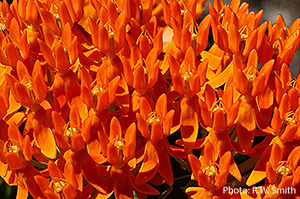
Above: Butterflyweed is frequently grown from seed in home gardens.
Fall is best for planting directly from seed, according to Xerces. Winter’s cold temperatures and moist conditions will stimulate germination. A scarcity of milkweed seeds native to some regions, including parts of Texas and Florida, has frustrated some gardeners, but in collaboration with the native seed industry, USDA and others, Xerces continues to develop new seed sources. Look for them under Project Milkweed at
www.xerces.org.
Some caveats. The stems and leaves of all milkweeds except
A. tuberosa produce a milky latex. This gooey substance is poisonous to many creatures and can be a skin irritant for some people. If you are new to handling milkweeds, wear gloves.
“Aphids are an issue with all milkweeds,” says DeLong-Amaya, “but they don’t jump to other plants. If you see an aphid on your plant, it’s not a big deal. Ladybugs take care of them. You can spray with soapy water every week or so. Make sure it makes direct contact with the aphids, and don’t worry if it doesn’t kill them all.”
Obviously, success with milkweeds in the garden means the leaves will be chewed to tatters by hungry caterpillars, so choose a low-profile location. If you don’t have a sunny one or you want to make the flowers a focal point, DeLong-Amaya suggests mixing milkweeds with other perennials of the same height so the chewed-up leaves won’t show as much. She recommends warm-season, mid-height grasses that won’t overpower milkweed flowers. Side-oats grama grass, for one, works well with
A. tuberosa.
“Naively perhaps, I do believe that if you plant it, they will come – ‘it’ being milkweeds,” says Wilson. “Perhaps, taking a literal leaf out of Lady Bird Johnson’s playbook, the north-south interstates could be planted with milkweeds and become corridors to aid the migration.” He has a proposal in the works seeking corporate support.
This is a big idea, and experts are convinced it will take large-scale, well-funded projects to keep monarchs even at current population levels, much less bring them back. But there is an upside to this dilemma: Monarchs are the rock stars of the insect world, with huge numbers of fans. Long before the term “citizen science” became familiar, volunteers were helping to count and tag the butterflies, developing data for valuable studies. Today, thousands of non-scientists of all ages are studying and helping monarchs through programs such as that run by Dr. Wilson at Texas A&M; Journey North; and Monarch Watch. Most of these groups emphasize the planting of milkweed and offer creative ways to involve children. If one child is inspired by the sight of a monarch caterpillar munching on the milkweed she helped plant, who knows how far her mind and heart may soar and where her dreams, ephemeral today as the butterflies themselves, may ultimately take the world?
Bibi Wein authored the award-winning memoir “The Way Home: A Wilderness Odyssey” (Tupelo Press). She lives in New York, and her work has appeared in numerous magazines and literary journals.










